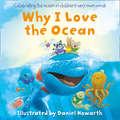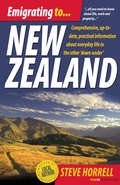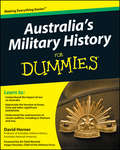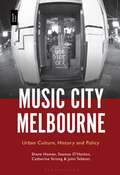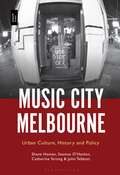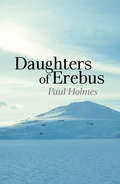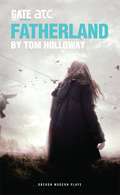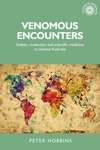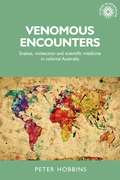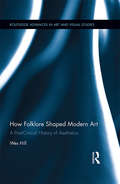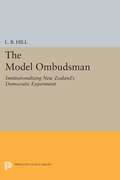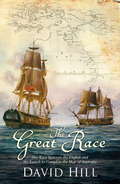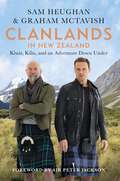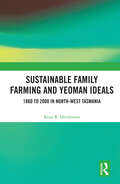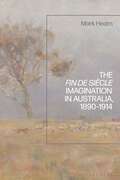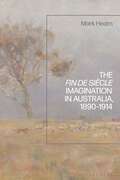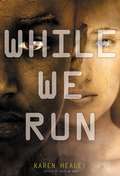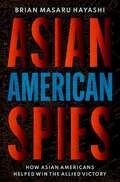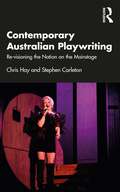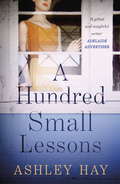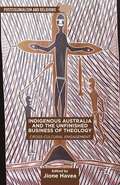- Table View
- List View
Why I Love the Ocean
by Daniel HowarthFeaturing children’s own words along with heart-warming pictures, this book is a perfect celebration of all that’s special about the ocean!
Emigrating To New Zealand: An Independent Guide
by Steve HorrellThis book is an indispensible guide to the roller coaster ride that is the emigration process. It covers all the topics and issues that anyone thinking of emigrating to New Zealand will need to know about, from the discussion phase through to making friends when you're there. - Deciding to go - Applying for a visa - Preparing to leave - Taking your pets - Arriving in New Zealand - House hunting and buying - Education and health - Cars and driving - Profiles of major cities and regions This thoroughly revised and updated new edition now includes a new chapter on how to find a job in New Zealand.
Australia's Military History For Dummies
by David HornerCreated especially for the Australian customer! The simple and easy way to get your mind around Australia's military history More people are visiting Gallipoli and walking the Kokoda Trail each year — now find out why. This complete guide helps you trace the story of Australia's involvement in war, from the colonial conflicts with the Indigenous population, through the World Wars to peacekeeping initiatives in East Timor and the controversial conflict in Afghanistan. Find out the origins of Australia's military history — go all the way back to the arrival of the First Fleet and the conflicts with the Indigenous peoples Learn about the heroism of the Anzacs — discover the origins of the legend of Gallipoli, and how the brass bungled the campaign Discover the horrors of war — consider the suffering and huge losses on the Western Front Recognise the successful battles of World Wars I and II — follow the Diggers' exploits in Palestine and Syria, and at Tobruk and Alamein Marvel at the grim jungle battles — track the Diggersthrough New Guinea, Borneo, Malaya and Vietnam between 1942 and 1972 Admire Australia's efforts to repel possible invaders — learn how Australians defended their country against the Japanese during World War II See how the Cold War heated up — witness the fight against communism in the Korean and Vietnam Wars Appreciate the modern-day Australian Defence Force — acknowledge the courage of the men and women who protectus into the 21st century Open the book and find: New insights into the meaning of Anzac Day Simple explanations of the structure of Australia's military Details of who fought whom, where, when and why Stories of Australia's great military fighters and leaders Accounts of the iconic battles that established Australia's reputation Locations of Australia's peacekeeping operations around the world Ways in which war and conflict have shaped the nation Reasons why Australia goes to war Learn to: Comprehend the impact of waron Australia Appreciate the heroism at AnzacCove and other significant battlefields Understand the controversies ofrecent conflicts, including in Vietnam and Iraq
Australia's Military History For Dummies (For Dummies Ser.)
by David HornerCreated especially for the Australian customer! The simple and easy way to get your mind around Australia's military history More people are visiting Gallipoli and walking the Kokoda Trail each year — now find out why. This complete guide helps you trace the story of Australia's involvement in war, from the colonial conflicts with the Indigenous population, through the World Wars to peacekeeping initiatives in East Timor and the controversial conflict in Afghanistan. Find out the origins of Australia's military history — go all the way back to the arrival of the First Fleet and the conflicts with the Indigenous peoples Learn about the heroism of the Anzacs — discover the origins of the legend of Gallipoli, and how the brass bungled the campaign Discover the horrors of war — consider the suffering and huge losses on the Western Front Recognise the successful battles of World Wars I and II — follow the Diggers' exploits in Palestine and Syria, and at Tobruk and Alamein Marvel at the grim jungle battles — track the Diggersthrough New Guinea, Borneo, Malaya and Vietnam between 1942 and 1972 Admire Australia's efforts to repel possible invaders — learn how Australians defended their country against the Japanese during World War II See how the Cold War heated up — witness the fight against communism in the Korean and Vietnam Wars Appreciate the modern-day Australian Defence Force — acknowledge the courage of the men and women who protectus into the 21st century Open the book and find: New insights into the meaning of Anzac Day Simple explanations of the structure of Australia's military Details of who fought whom, where, when and why Stories of Australia's great military fighters and leaders Accounts of the iconic battles that established Australia's reputation Locations of Australia's peacekeeping operations around the world Ways in which war and conflict have shaped the nation Reasons why Australia goes to war Learn to: Comprehend the impact of waron Australia Appreciate the heroism at AnzacCove and other significant battlefields Understand the controversies ofrecent conflicts, including in Vietnam and Iraq
Music City Melbourne: Urban Culture, History and Policy
by Shane Homan Seamus O’Hanlon Catherine Strong John TebbuttHow did Melbourne earn its place as one of the world's 'music cities'? Beginning with the arrival of rock 'n' roll in the 1950s, this book explores the development of different sectors of Melbourne's popular music ecosystem in parallel with broader population, urban planning and media industry changes in the city. The authors draw on interviews with Melbourne musicians, venue owners and policy-makers, documenting their ambitions and experiences across different periods, with accompanying spotlights on the gendered, multicultural and indigenous contexts of playing and recording in Melbourne. Focusing on pop and rock, this is the first book to provide an extensive historical lens of popular music within an urban cultural economy that in turn investigates the contemporary nature and challenges of urban music activities and policy.
Music City Melbourne: Urban Culture, History and Policy
by Shane Homan Seamus O’Hanlon Catherine Strong John TebbuttHow did Melbourne earn its place as one of the world's 'music cities'? Beginning with the arrival of rock 'n' roll in the 1950s, this book explores the development of different sectors of Melbourne's popular music ecosystem in parallel with broader population, urban planning and media industry changes in the city. The authors draw on interviews with Melbourne musicians, venue owners and policy-makers, documenting their ambitions and experiences across different periods, with accompanying spotlights on the gendered, multicultural and indigenous contexts of playing and recording in Melbourne. Focusing on pop and rock, this is the first book to provide an extensive historical lens of popular music within an urban cultural economy that in turn investigates the contemporary nature and challenges of urban music activities and policy.
Daughters of Erebus
by Paul HolmesHow 287 people died in the air crash on Mt Erebus. What caused the crash and who covered it up
Fatherland (Oberon Modern Plays)
by Tom HollowayTogether we have something and share a passion that other people will never understand' Mark and Angela are a father and daughter grappling with a painful past and fragile future. Tonight, an innocent evening of ice cream and DVDs derails quickly into dangerous territory in this chilling new story about a father who loved too deeply.
Venomous encounters: Snakes, vivisection and scientific medicine in colonial Australia (PDF) (Studies in Imperialism)
by Peter HobbinsVenomous encounters presents a radically new view of the role of science and scientific methodology in the colonies. It explores the role of snakes, snakebite and snake venom in the emerging science of 19th-century Australia and India, the neglected significance of inter-colony exchanges and conflicts and the importance of vivisection to science.
Venomous encounters: Snakes, vivisection and scientific medicine in colonial Australia (Studies in Imperialism)
by Peter HobbinsVenomous encounters presents a radically new view of the role of science and scientific methodology in the colonies. It explores the role of snakes, snakebite and snake venom in the emerging science of 19th-century Australia and India, the neglected significance of inter-colony exchanges and conflicts and the importance of vivisection to science.
How Folklore Shaped Modern Art: A Post-Critical History of Aesthetics (Routledge Advances in Art and Visual Studies)
by Wes HillSince the 1990s, artists and art writers around the world have increasingly undermined the essentialism associated with notions of "critical practice." We can see this manifesting in the renewed relevance of what were previously considered "outsider" art practices, the emphasis on first-person accounts of identity over critical theory, and the proliferation of exhibitions that refuse to distinguish between art and the productions of culture more generally. How Folklore Shaped Modern Art: A Post-Critical History of Aesthetics underscores how the cultural traditions, belief systems and performed exchanges that were once integral to the folklore discipline are now central to contemporary art’s "post-critical turn." This shift is considered here as less a direct confrontation of critical procedures than a symptom of art’s inclusive ideals, overturning the historical separation of fine art from those "uncritical" forms located in material and commercial culture. In a global context, aesthetics is now just one of numerous traditions informing our encounters with visual culture today, symptomatic of the pull towards an impossibly pluralistic image of art that reflects the irreducible conditions of identity.
How Folklore Shaped Modern Art: A Post-Critical History of Aesthetics (Routledge Advances in Art and Visual Studies #15)
by Wes HillSince the 1990s, artists and art writers around the world have increasingly undermined the essentialism associated with notions of "critical practice." We can see this manifesting in the renewed relevance of what were previously considered "outsider" art practices, the emphasis on first-person accounts of identity over critical theory, and the proliferation of exhibitions that refuse to distinguish between art and the productions of culture more generally. How Folklore Shaped Modern Art: A Post-Critical History of Aesthetics underscores how the cultural traditions, belief systems and performed exchanges that were once integral to the folklore discipline are now central to contemporary art’s "post-critical turn." This shift is considered here as less a direct confrontation of critical procedures than a symptom of art’s inclusive ideals, overturning the historical separation of fine art from those "uncritical" forms located in material and commercial culture. In a global context, aesthetics is now just one of numerous traditions informing our encounters with visual culture today, symptomatic of the pull towards an impossibly pluralistic image of art that reflects the irreducible conditions of identity.
The Model Ombudsman: Institutionalizing New Zealand's Democratic Experiment
by L. B. HillOne increasingly popular device for achieving a balance between authority and accountability in government is the institution of the ombudsman. The first non-Scandinavian ombudsman appeared in New Zealand in 1962, and since then the office has spread to many countries and been adopted at different levels of government. This book—the first intensive study of New Zealand's "model" ombudsman- seeks to understand the process by which the institution was successfully adapted and made a part of New Zealand's political system. The author's inquiry is based on eighteen months of field experience in New Zealand. His book examines the complaints, the clients, their interaction with the ombudsman, his relations with the bureaucracy, and his effectiveness. His relations with various publics-bureaucrats, Honorable Members, and Queen's Ministers receive special attention.Originally published in 1977.The Princeton Legacy Library uses the latest print-on-demand technology to again make available previously out-of-print books from the distinguished backlist of Princeton University Press. These editions preserve the original texts of these important books while presenting them in durable paperback and hardcover editions. The goal of the Princeton Legacy Library is to vastly increase access to the rich scholarly heritage found in the thousands of books published by Princeton University Press since its founding in 1905.
The Great Race: The Race Between the English and the French to Complete the Map of Australia
by David HillOn the afternoon of 8 April 1802, in the remote southern ocean, two explorers had a remarkable chance encounter. Englishman Matthew Flinders and Frenchman Nicolas Baudin had been sent by their governments on the same quest: to explore the uncharted coast of the great south land and find out whether the west and east coasts, four thousand kilometres apart, were part of the same island. And so began the race to compile the definitive map of Australia. These men's journeys were the culmination of two hundred years of exploration of the region by the Dutch - most famously Abel Tasman - the Portuguese, the Spanish and by Englishmen such as the colourful pirate William Dampier and, of course, James Cook. The three-year voyages of Baudin and Flinders would see them endure terrible hardships in the spirit of discovery. They suffered scurvy and heat exhaustion, and Flinders was shipwrecked and imprisoned - always knowing he was competing with the French to produce the first map of this mysterious continent. Written from diaries and other first-hand accounts, this is the thrilling story of men whose drawings recorded countless previously unknown species and turned mythical creatures into real ones, and whose skill and determination enabled Terra Australis Incognita to become Australia.
Clanlands in New Zealand: Kiwis, Kilts, and an Adventure Down Under
by Sam Heughan Graham McTavish*With a foreword by Sir Peter Jackson*Buckle up, grab a dram, and get ready for another unforgettable wild ride.They're back! Stars of Outlander, Sam Heughan and Graham McTavish are no strangers to the rugged beauty of Scotland. But this time they're setting their sights on a new horizon: New Zealand.Join our intrepid Scotsmen on their latest epic adventure across The Land of the Long White Cloud in this thrilling follow-up to Clanlands. Setting out to explore a country that Graham calls home, and that Sam has longed to visit, these sturdy friends immerse themselves in all that New Zealand has to offer: stunning landscapes, rich history, world-class food and drink, and - much to Graham's mounting anxiety and Sam's deep satisfaction - famously adrenaline-fuelled activities! As ever there's not nearly enough space in their trusty camper van and with plenty of good-natured competition and tormenting to go around, Sam and Graham's friendship is put to the test once again. Along the way we learn about the length and breadth of this jewel of the Southern Seas, exploring the fascinating story of its people while testing the very limits of Graham's sanity.Like the very best buddy movie sequel, this latest instalment is full of unforgettable experiences and loveable characters and promises to be an even more memorable ride with two of the most entertaining travel companions around.So, say goodbye to your inhibitions and kia ora to New Zealand like you've never seen it before.
Sustainable Family Farming and Yeoman Ideals: 1860 to 2000 in North-West Tasmania
by Rena R. HendersonWithin the frame of family farming, this book offers a longitudinal study of the Castra district in North-West Tasmania from first European settlement to the end of the twentieth century. It draws upon historical sources for yeomanry characteristics from Britain, Canada, the USA, New Zealand and Australian mainland colonies to show how these characteristics were persistently supportive of family farming. Surveying farming communities over several generations, this book explores a range of topics including colonial surveying practices, settler families’ motivation, attributes and demographics, the role of Methodism, the ways children were inculcated into yeoman farming enterprises, the role of women as companionate wives, and the political participation of farmers in the public sphere. The book also offers a new perspective of three commonly-held myths of settlement failure: the settlement of retired Anglo-Indian military and civil officers in the 1870s, the settlement of soldiers on small farms after the Great War, and the claims that the ideal of yeoman family farming was anachronistic to capitalist commodity production. The book draws from a wide selection of previously underused primary source materials, including oral histories from current and past residents, to provide a comprehensive overview of an important aspect of rural Australian history.The book is a valuable contribution to Australian historiography, and will be a useful resource for students and scholars of rural history, social history, environmental history, colonialism and sustainable agriculture.
Sustainable Family Farming and Yeoman Ideals: 1860 to 2000 in North-West Tasmania
by Rena R. HendersonWithin the frame of family farming, this book offers a longitudinal study of the Castra district in North-West Tasmania from first European settlement to the end of the twentieth century. It draws upon historical sources for yeomanry characteristics from Britain, Canada, the USA, New Zealand and Australian mainland colonies to show how these characteristics were persistently supportive of family farming. Surveying farming communities over several generations, this book explores a range of topics including colonial surveying practices, settler families’ motivation, attributes and demographics, the role of Methodism, the ways children were inculcated into yeoman farming enterprises, the role of women as companionate wives, and the political participation of farmers in the public sphere. The book also offers a new perspective of three commonly-held myths of settlement failure: the settlement of retired Anglo-Indian military and civil officers in the 1870s, the settlement of soldiers on small farms after the Great War, and the claims that the ideal of yeoman family farming was anachronistic to capitalist commodity production. The book draws from a wide selection of previously underused primary source materials, including oral histories from current and past residents, to provide a comprehensive overview of an important aspect of rural Australian history.The book is a valuable contribution to Australian historiography, and will be a useful resource for students and scholars of rural history, social history, environmental history, colonialism and sustainable agriculture.
The Fin de Siècle Imagination in Australia, 1890-1914
by Mark HearnThis book explores the fin de siècle, an era of powerful global movements and turbulent transition, in Australia and beyond through a series of biographical microhistories. From the first wave feminist Rose Summerfield and the working class radical John Dwyer, to the indigenous rights advocate David Unaipon and the poet Christopher Brennan, Hearn traces the transnational identities, philosophies, ideas and cultures that characterised this era. Examining the struggles and aspirations of fin de siècle lives; respect for the rights of women and indigenous peoples, the injustices and hardship inflicted on working men and women, and the ways in which they imagined a better world, this book examines the transformation and renewal brought about by fin de siècle ideas. It examines the distinctive characteristics of this 'great acceleration' of economic, technological and cultural forces that swept the globe at the turn of the 19th century both within an Australian context and on the world stage. Asserting that the fin de siècle was significant for the making of modern Australia, and demonstrating the impact Australian fin de siècle lives had on the transnational and global movements of the era, Mark Hearn traces the turbulent nature of the fin de siècle imagination in Australia, and its response to these dynamic forces.
The Fin de Siècle Imagination in Australia, 1890-1914
by Mark HearnThis book explores the fin de siècle, an era of powerful global movements and turbulent transition, in Australia and beyond through a series of biographical microhistories. From the first wave feminist Rose Summerfield and the working class radical John Dwyer, to the indigenous rights advocate David Unaipon and the poet Christopher Brennan, Hearn traces the transnational identities, philosophies, ideas and cultures that characterised this era. Examining the struggles and aspirations of fin de siècle lives; respect for the rights of women and indigenous peoples, the injustices and hardship inflicted on working men and women, and the ways in which they imagined a better world, this book examines the transformation and renewal brought about by fin de siècle ideas. It examines the distinctive characteristics of this 'great acceleration' of economic, technological and cultural forces that swept the globe at the turn of the 19th century both within an Australian context and on the world stage. Asserting that the fin de siècle was significant for the making of modern Australia, and demonstrating the impact Australian fin de siècle lives had on the transnational and global movements of the era, Mark Hearn traces the turbulent nature of the fin de siècle imagination in Australia, and its response to these dynamic forces.
While We Run
by Karen HealeyIt's 2127, and the future is at stake . . . Abdi Taalib thought he was moving to Australia for a music scholarship. But after meeting the beautiful and brazen Tegan Oglietti, his world was turned upside down. Tegan's no ordinary girl - she died in 2027, only to be frozen and brought back to life in Abdi's time, 100 years later. Now, all they want is for things to return to normal (or as normal as they can be), but the government has other ideas. Especially since the two just spilled the secrets behind Australia's cryonics project to the world. On the run, Abdi and Tegan have no idea who they can trust - and, when they uncover startling new details about the program, they realize that thousands of lives may be in their hands. Karen Healey offers a suspenseful, page-turning companion to When We Wake that will keep readers on the edge of their seats and make them call into question their own ideas about morality -- and mortality, too.
Asian American Spies: How Asian Americans Helped Win the Allied Victory
by Brian Masaru HayashiA recovery of the vital role Chinese, Japanese, and Korean Americans played in US intelligence services in Asia during World War II. Spies deep behind enemy lines; double agents; a Chinese American James Bond; black propaganda radio broadcasters; guerrilla fighters; pirates; smugglers; prostitutes and dancers as spies; and Asian Americans collaborating with Axis Powers. All these colorful individuals form the story of Asian Americans in the Office of Strategic Services (OSS), the forerunner of today's CIA. Brian Masaru Hayashi brings to light for the first time the role played by Chinese, Japanese, and Korean Americans in America's first centralized intelligence agency in its fight against the Imperial Japanese forces in east Asia during World War II. They served deep behind enemy lines gathering intelligence for American and Chinese troops locked in a desperate struggle against Imperial Japanese forces on the Asian continent. Other Asian Americans produced and disseminated statements by bogus peace groups inside the Japanese empire to weaken the fighting resolve of the Japanese. Still others served with guerrilla forces attacking enemy supply and communication lines behind enemy lines. Engaged in this deadly conflict, these Asian Americans agents encountered pirates, smugglers, prostitutes, and dancers serving as the enemy's spies, all the while being subverted from within the OSS by a double agent and without by co-ethnic collaborators in wartime Shanghai. Drawing on recently declassified documents, Asian American Spies challenges the romanticized and stereotyped image of these Chinese, Japanese, and Korean American agents--the Model Minority-while offering a fresh perspective on the Allied victory in the Pacific Theater of World War II.
Contemporary Australian Playwriting: Re-visioning the Nation on the Mainstage
by Chris Hay Stephen CarletonContemporary Australian Playwriting provides a thorough and accessible overview of the diverse and exciting new directions that Australian Playwriting is taking in the twenty-first century. In 2007, the most produced playwright on the Australian mainstage was William Shakespeare. In 2019, the most produced playwright on the Australian mainstage was Nakkiah Lui, a Gamilaroi and Torres Strait Islander woman. This book explores what has happened both on stage and off to generate this remarkable change. As writers of colour, queer writers, and gender diverse writers are produced on the mainstage in larger numbers, they bring new critical directions to the twenty-first century Australian stage. At a politically turbulent time when national identity is fractured, this book examines the ways in which Australia’s leading playwrights have interrogated, problematised, and tried to make sense of the nation. Tracing contemporary trends, the book takes a thematic approach to the re-evaluation of the nation that is dramatized in key Australian plays. Each chapter is accompanied by a duologue between two of the playwrights whose work has been analysed, to provide a dual perspective of theory and practice.
Contemporary Australian Playwriting: Re-visioning the Nation on the Mainstage
by Chris Hay Stephen CarletonContemporary Australian Playwriting provides a thorough and accessible overview of the diverse and exciting new directions that Australian Playwriting is taking in the twenty-first century. In 2007, the most produced playwright on the Australian mainstage was William Shakespeare. In 2019, the most produced playwright on the Australian mainstage was Nakkiah Lui, a Gamilaroi and Torres Strait Islander woman. This book explores what has happened both on stage and off to generate this remarkable change. As writers of colour, queer writers, and gender diverse writers are produced on the mainstage in larger numbers, they bring new critical directions to the twenty-first century Australian stage. At a politically turbulent time when national identity is fractured, this book examines the ways in which Australia’s leading playwrights have interrogated, problematised, and tried to make sense of the nation. Tracing contemporary trends, the book takes a thematic approach to the re-evaluation of the nation that is dramatized in key Australian plays. Each chapter is accompanied by a duologue between two of the playwrights whose work has been analysed, to provide a dual perspective of theory and practice.
A Hundred Small Lessons: A Novel
by Ashley Hay'I love Ashley Hay's writing . . . it's so poised and beautiful.' Guardian'A moving and lyrical story of marriage, motherhood and age. Highly recommend.' Cari Rosen, author of The Secret Diary of a New Mum (Aged 43 1/4)When Elsie Gormley leaves the Brisbane house in which she has lived for more than sixty years, Lucy Kiss and her family move in, eager to establish their new life. As they settle in, Lucy and her husband Ben struggle to navigate their transformation from adventurous lovers to new parents, taking comfort in memories of their vibrant past as they begin to unearth who their future selves might be. But the house has secrets of its own, and the rooms seem to share recollections of Elsie's life with Lucy.In her nearby nursing home, Elsie traces the span of her life-the moments she can't bear to let go and the places to which she dreams of returning. Her beloved former house is at the heart of her memories of marriage, motherhood, love, and death, and the boundary between present and past becomes increasingly porous for both her and Lucy.Over the course of one hot Brisbane summer, two families' stories intersect in sudden and unexpected ways. Through the richly intertwined narratives of two ordinary, extraordinary women, Ashley Hay uses her lyrical prose, poetic dialogue, and stunning imagery to weave an intricate, bighearted story of what it is to be human.
Indigenous Australia and the Unfinished Business of Theology: Cross-Cultural Engagement (Postcolonialism and Religions)
by Jione HaveaThis book engages a complex subject that mainline theologies avoid, Indigenous Australia. The heritages, wisdoms and dreams of Indigenous Australians are tormented by the discriminating mindsets and colonialist practices of non-Indigenous peoples. This book gives special attention to the torments due to the arrival and development of the church.
